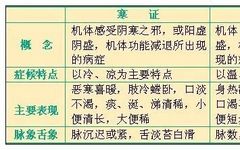
ClickBlue↑FollowUs!
Cold and heat are the two main principles for distinguishing the nature of diseases. Cold syndromes and heat syndromes reflect the excess and deficiency of Yin and Yang in the body. An excess of Yin or deficiency of Yang manifests as a cold syndrome; an excess of Yang or deficiency of Yin manifests as a heat syndrome. The differentiation of cold and heat is of great significance in treatment. As stated in the “Suo Wen: The Great Discussion of True Essentials”: “Cold is treated with heat,” and “Heat is treated with cold,” indicating that the treatment methods for the two are exactly opposite. Therefore, the differentiation of cold and heat must be precise.

1. Cold Syndrome

2. Heat Syndrome
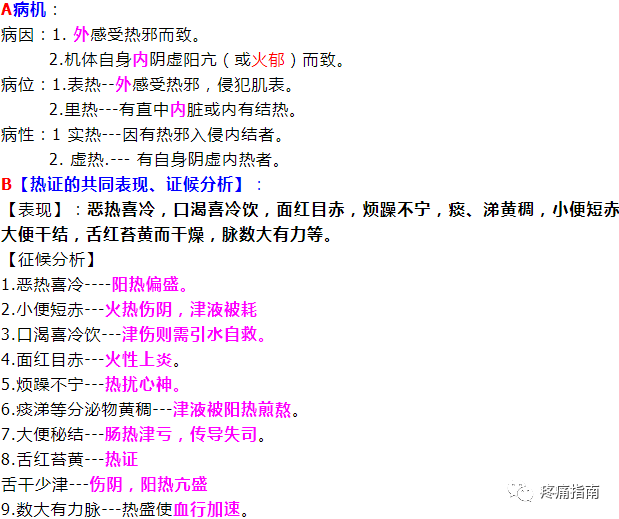
3. Differentiation of Cold and Heat Syndromes
To differentiate between cold and heat syndromes, one cannot make judgments based solely on a single symptom; rather, a comprehensive observation and analysis of the entire manifestation of the disease is necessary, especially regarding the preferences and aversions to cold and heat, thirst or lack of thirst; the complexion’s redness or paleness, the temperature of the limbs, as well as the urination, tongue appearance, and pulse should be observed in detail.
4. Relationship Between Cold and Heat Syndromes
Although cold and heat syndromes are essentially different, they are interrelated. They can appear simultaneously in the same patient, manifesting as mixed cold and heat symptoms, and can also transform into one another under certain conditions, resulting in cold transforming into heat and heat transforming into cold. During the progression of a disease, especially in critical stages, phenomena of false cold or false heat may also occur.
(1) Mixed Cold and Heat
The simultaneous appearance of cold and heat syndromes in the same patient is referred to as mixed cold and heat. There are different types of mixed cold and heat, including upper and lower mixed cold and heat, and exterior and interior mixed cold and heat.
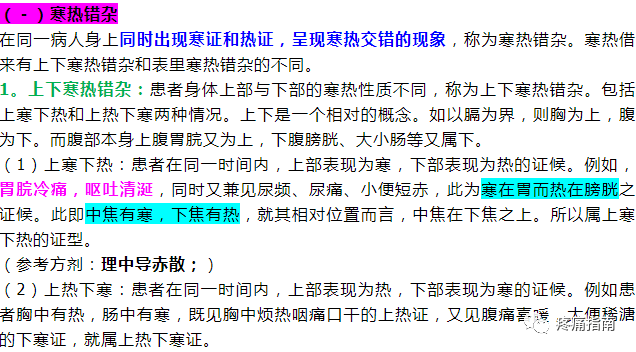
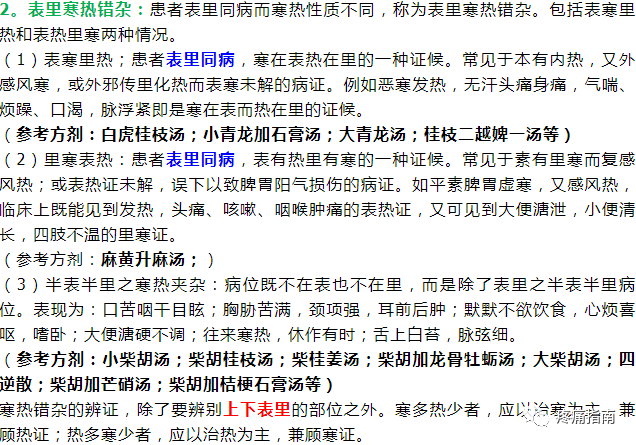
(2) Transformation of Cold and Heat
1. Transformation of Cold Syndrome into Heat Syndrome: A patient initially presents with a cold syndrome, which later develops into a heat syndrome. As the heat syndrome appears, the cold syndrome gradually disappears, indicating the transformation from cold to heat. This often occurs due to an excess of Yang Qi in the body, where cold evil transforms into heat, or may be seen in patients who have been improperly treated with excessive warming and drying herbs. For example, when a patient is affected by cold evil, they initially present with exterior cold symptoms, showing aversion to cold and fever, no sweating, a white tongue coating, and a floating tight pulse. As the condition progresses, the cold evil penetrates deeper, transforming into heat, with aversion to cold symptoms subsiding, while strong fever, irritability, thirst, a yellow tongue coating, and a rapid pulse appear, indicating the transformation from exterior cold to interior heat.
2. Transformation of Heat Syndrome into Cold Syndrome: A patient initially presents with a heat syndrome, which later develops into a cold syndrome. As the cold syndrome appears, the heat syndrome gradually disappears, indicating the transformation from heat to cold. This often occurs due to an excess of evil or deficiency of righteous Qi, where the righteous Qi cannot overcome the evil, leading to functional decline; it can also be seen in patients who have been improperly treated, damaging Yang Qi. This transformation can be gradual or rapid. For instance, in chronic heat dysentery, the Yang Qi is gradually consumed, transforming into a deficiency cold dysentery, which is a slow transformation. In contrast, in a patient with high fever, due to excessive sweating, Yang Qi is lost through sweat, or due to excessive vomiting or diarrhea, Yang Qi is lost with fluids, leading to a sudden drop in body temperature, cold limbs, pale complexion, and a weak pulse, indicating a rapid transformation into a deficiency cold syndrome (loss of Yang).
The transformation of cold and heat syndromes reflects the condition of the excess and deficiency of evil and righteous Qi. The transformation from cold to heat indicates that the righteous Qi is still strong, and the cold evil is stagnant and transforms into heat; the transformation from heat to cold often indicates an excess of evil and deficiency of righteous Qi, where the righteous Qi cannot overcome the evil.
(3) True and False Cold and Heat
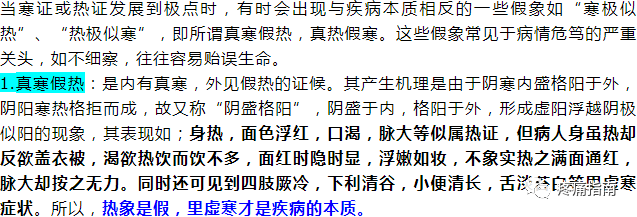

5. Relationship Between Cold and Heat and Exterior and Interior
Cold and heat syndromes are interrelated with exterior and interior conditions. They can form various syndromes, in addition to the aforementioned exterior cold with interior heat and exterior heat with interior cold, there are also exterior cold syndrome, exterior heat syndrome, interior cold syndrome, and interior heat syndrome. These are described as follows:
(1) Exterior Cold Syndrome
This is a disease caused by cold evil invading the exterior.
Clinical Manifestations: Severe aversion to cold, mild fever, body aches, no sweating, thin white moist tongue coating, floating tight pulse.
Syndrome Analysis: Cold evil invades the exterior, injuring the defensive Yang, which cannot warm the exterior, leading to severe aversion to cold. The righteous Qi contends with the evil, and when Yang Qi is obstructed, fever occurs; cold is Yin evil, hence the severe aversion to cold and mild fever. Cold evil stagnates the meridians, causing obstruction of Qi, leading to body aches. Cold evil constricts, closing the pores, hence no sweating; the floating tight pulse is a sign of cold evil constraining the exterior. Exterior cold syndrome is a type of exterior syndrome characterized by severe aversion to cold, mild fever, no sweating, and a floating tight pulse.
(2) Exterior Heat Syndrome
This is a disease caused by heat evil invading the exterior.
Clinical Manifestations: Fever, slight aversion to wind and cold, headache, dry mouth, slight thirst, possible sweating, red tongue edges, rapid floating pulse.
Syndrome Analysis: Heat evil invades the exterior, obstructing the defensive Qi, hence fever and aversion to cold. Heat is Yang evil, hence the fever is more pronounced while aversion to cold is mild, often accompanied by dry mouth and slight thirst. Heat nature rises and disperses, leading to sweating; heat evil disturbs the head, causing headache. The red edges of the tongue and rapid floating pulse are signs of warmth at the exterior.
Exterior heat syndrome is also a type of exterior syndrome characterized by pronounced fever, mild aversion to cold, often with sweating, and a floating rapid pulse.
(3) Interior Cold Syndrome
This is a disease caused by cold evil invading the internal organs or deficiency of Yang Qi.
Clinical Manifestations: Cold body and limbs, pale complexion, no thirst or preference for warm drinks, quiet and less talkative, clear long urination, loose stools, pale tongue, white moist coating, slow deep pulse.
Syndrome Analysis: Cold evil invades the internal organs, damaging Yang Qi, or the functional decline of the internal organs leads to deficiency of Yang Qi, both of which cannot warm the body, hence cold body and limbs, pale complexion. With internal Yin cold, fluids are not harmed, hence no thirst or preference for warm drinks. Cold belongs to Yin and is associated with quietness, hence quiet and less talkative. Clear urination and loose stools, pale tongue with white moist coating, and slow deep pulse are all signs of interior cold.
(4) Interior Heat Syndrome
This is a disease caused by heat evil invading the internal organs or deficiency of Yin fluids leading to internal heat.
Clinical Manifestations: Red face and body heat, thirst, preference for cold drinks, irritability and talkativeness, short red urination, dry stools, red tongue, yellow coating, rapid pulse.
Syndrome Analysis: Interior heat is excessive, rising to the exterior, hence red face and body heat. Heat injures fluids, hence thirst for cold drinks. Heat is Yang, which is active, hence irritability and talkativeness. Heat injures fluids, leading to short red urination. Heat in the intestines leads to fluid deficiency, causing dry stools. Red tongue, yellow coating, and rapid pulse are all signs of interior heat.
Next Issue Preview
Deficiency and excess are the two main principles for distinguishing the excess and deficiency of evil and righteous Qi. Deficiency refers to insufficient righteous Qi; excess refers to the strong presence of evil Qi. Deficiency syndrome reflects the weakness of the body’s righteous Qi while the evil Qi is not too strong. Excess syndrome reflects the strong presence of evil Qi while the righteous Qi has not yet weakened, indicating a fierce struggle between evil and righteous Qi. Differentiating between deficiency and excess can help understand the condition of the patient’s evil and righteous Qi, providing a basis for treatment; excess syndromes should be attacked, while deficiency syndromes should be tonified. Only with accurate differentiation can appropriate treatment be applied, avoiding the mistakes of confusing deficiency with excess.
Yin and Yang are the overarching principles of the Eight Principles differentiation. In diagnosis, diseases can be classified into two main aspects of Yin and Yang based on the pathological nature of clinical manifestations. Yin and Yang essentially serve as the overarching principles of the Eight Principles, encompassing the other six aspects: exterior, heat, and excess belong to Yang; interior, cold, and deficiency belong to Yin. Hence, some refer to the Eight Principles as “Two Principles and Six Essentials.”
In clinical practice, since the relationships between exterior and interior, cold and heat, deficiency and excess are sometimes intertwined, they cannot be distinctly separated. Therefore, the differentiation between Yin and Yang is also not always clear-cut, often presenting complex syndromes where Yin contains Yang and Yang contains Yin. The syndromes mentioned above, such as simultaneous exterior and interior diseases, mixed cold and heat, and mixed deficiency and excess, belong to this category.
In addition to Yin and Yang syndromes, there are also syndromes such as true Yin deficiency, true Yang deficiency, and loss of Yin and Yang.
This article is sourced from the internet. If there is any infringement, please contact us for resolution!
Your likes are our motivation for progress!
↘↘↘

